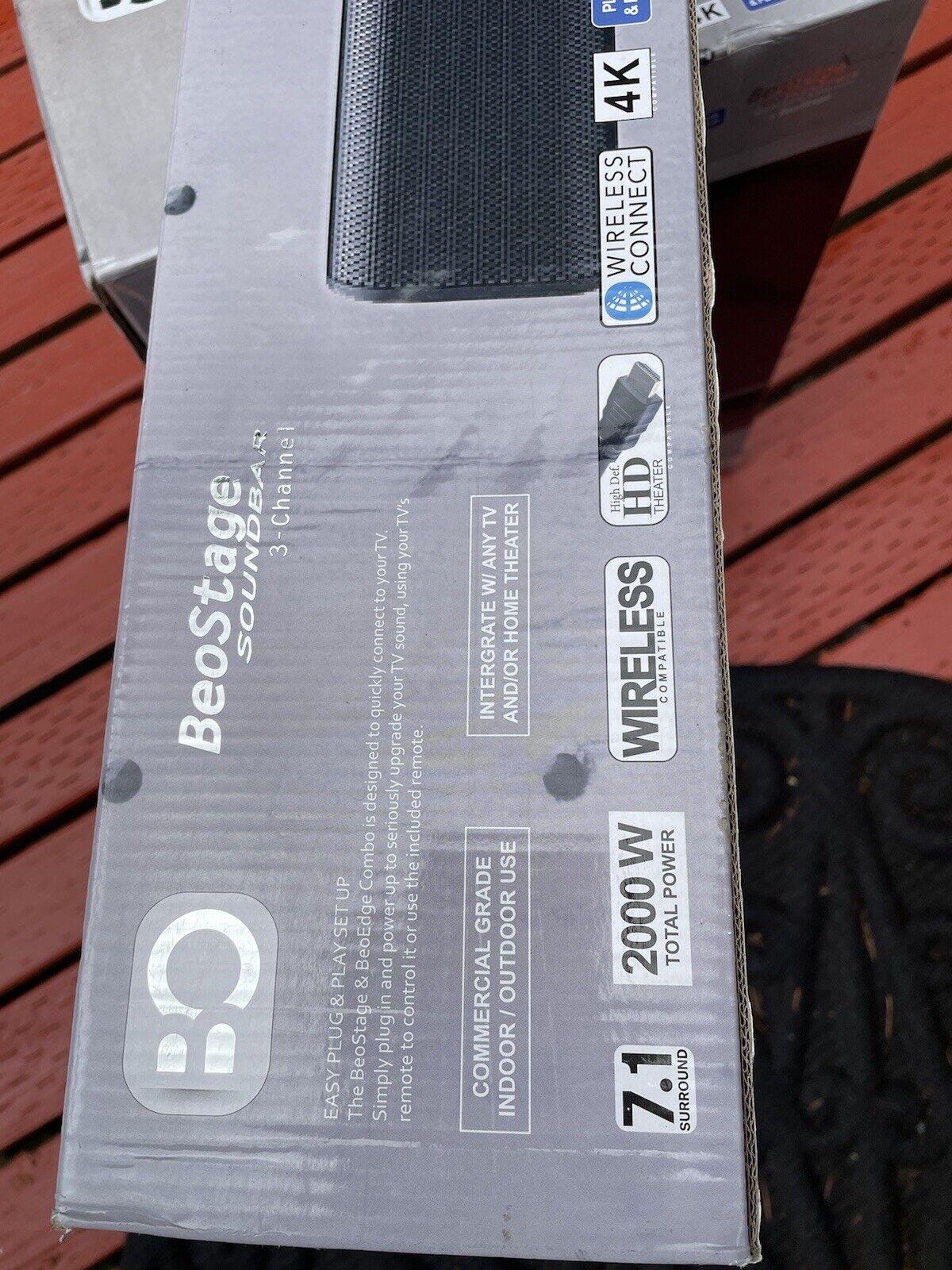Forum Replies Created
-
AuthorPosts
-
Mark
BRONZE MemberOne advantage to this marketplace over a white van in the parking lot is that the buyer should have an avenue to getting a refund. Ebay or PayPal should refund the money if the buyer finds that this product doesn’t work as expected. The person who buys this probably just has a faint knowledge of B&O and that it is a high-end brand. They probably don’t know how their products sound, so either they will except this fake product for how it sounds or think B&O is really junk and ask for a refund.
Mark
BRONZE MemberThis looks like its just an evolution of the white van speaker scam, but now on-line.
Mark
BRONZE MemberHere is a picture from one of the eBay listings for a Beosound Stage with the BO logo

Mark
BRONZE MemberHow on earth do they get away with this?
They don’t have any contact information on their pages and I think the bulk of the sellers have no reputation of their own and can easily go away after a sale come back as a different seller. If B&O wanted to protect their reputation and go after them, who would they go after, their founder “John”? I think they are careful not to associate their “Beo” products with B&O on their website, they leave that for their sellers to do that.
I just wonder what they are really selling?
Mark
BRONZE MemberThey are not targeting people who really know B&O, just those that know their reputation for quality products. Their website does a pretty good job of not being affiliated with B&O, but the product box sold by questionable sellers might be a little more misleading.
Mark
BRONZE MemberHowever, what is their path forward if they don’t go upmarket. HiFi is dead. Long live the bluetooth/ stand alone speaker.
This is a very interesting and I’m afraid accurate statement.
For most people there is a “good enough” solution for music where the bluetooth and stand-alone speaker fits the need perfectly. It doesn’t need to be a true stereo system because they are not sitting down listening to music. How large is the market for a HiFi system? For me growing up, going to audio stores and looking at the equipment was a lot of fun. Looking for improvements to your system was always a goal. Music was that important to us. Even in the upmarket realm, is B&O finding true audio lovers or are they just home decor enthusiasts who love the retro look of the Beosound 9000 and the Beogram 4000c?
Mark
BRONZE MemberI have the Halo and the B&O charging pad. I was never impressed with it and I no longer use it to charge the Halo. It seemed very difficult to charge the Halo to 100% on it and that’s if the light on the pad stayed solid. It wasn’t unusual for it to start blinking indicating some problem. I actually have better results charging the Halo on the Beosound A5.
I bought the Halo/charger for a friend and her experiences have been similar.
I wish I used the Halo more…
Mark
BRONZE MemberThanks T.W.G
I now think you are right. I will have to find a suitable preamp to handle my needs as I don’t think any other solution will become available soon.
I have a facination with old technology. I have working telepbones from the 1930’s in my home and I love old audio equipment, including an AM radio from 1924. My main system is built around the Beosound Theatre and I would love to be able to show off old sources to people who aren’t familiar with them anymore. I guess this is a very niche market today.
Mark
BRONZE MemberIs that the elegant B&O-style solution that you would like?
Mark
BRONZE MemberIf they are not selling rebuilt B&O cartridges then they would almost have to be a UK distributer for Soundsmith. Soundsmith is licensed and authorized by B&O to make replacement cartridges, and they claim to be the only entity to do so. Peter Ledermann had to reverse engineer existing cartridges in order to make new ones. If these UK dealers are selling a cartridge made by someone else I would be very leery in buying one. Don’t be afraid to ask, but I’m sure it’s Soundsmith.
Mark
BRONZE MemberAre the UK sellers selling the Soundsmith cartridges or rebuilt MMC cartridges? I don’t think there are any other options. Either way it would probably be a safe purchase.
Mark
BRONZE MemberThe value of a Beogram 8500, or any, is up to how much a person is willing to spend for any given condition. £400 to me does not sound like a lot, especially if it is in working condition. I see the 8500 going for £1,949.99 and £1,650.00, so if the one you see is in working condition it may be a bargain. What would be a comfortable price for you?
You have to be careful purchasing a turntable from eBay because if it is not packaged correctly it could arrive in pretty poor condition. I’ve purchased a few players that arrived with parts broken that needed to be repaired after I received it. I purchased an 8002 that was completely refurbish by the seller for $1500 without cartridge, and for me it was a bargain and I love it a lot! Luckily the seller knew how to package it for shipping.
Mark
BRONZE MemberI have a couple of soundsmith cartridges and I am very happy with them so I think you made a good decision. I understand the desire to keep the turntable 100% B&O with a rebuilt MMC cartridge as the B&O cartridge has a little more refined look to them, and I’ve heard they sound a bit different. Better or worse is subjective but I hear that Peter can build or modify the cartridge to sound like the original B&O, but I don’t have any experience in that.
I hope you enjoy the turntable and the experience!
Mark
BRONZE MemberAs I am very knew to the audio world, could you perhaps explain to me why these preamps make better sound than an internal RIAA preamp? Is the difference big?
A quick disclaimer, my figures are based off a Google search.
The need for a phono preamp:
Signal levels for a phono output will range between 0.0002 Volt and 0.007 Volt.
The standard CD-player output voltage is 2V RMS, with units varying between 1.74V on the low side and a whopping 7.2V on the high side.
Job 1 of a phono preamp is to amplify the very small phono output to be around the 2V RMS of a CD player to have adequate volume when sending the signal to the amplifier. The phono preamp should do this without introducing noise or distortion to the signal.
Job 2 of a phono preamp is to apply the RIAA EQ curve to the phono signal, ensuring that your records sound balanced and accurate.
The RIAA EQ curve boosts the bass and treble frequencies to compensate for the inherent roll-off of these frequencies that occurs during the recording and playback process.
The better the cartridge the better the phono preamp should be to get the most out of the cartridge. It all depends how “picky” you want to be when you listen to records. I’m sure an internal phono preamp can be quite good depending on who is making it and what their standards are.
Mark
BRONZE MemberI have a large CD collection of great variety dating back to the mid 1980’s. I still buy CDs and rip them into my iTunes library and listen to them from there, I rarely listen to them on my Oppo player anymore.
The matter of sound quality differences is highly controversial, but I don’t think it really matters much because we tend to adapt to what we have if we are enjoying it. Is CD better than a streamed version, would the music sound better coming from Beolab 50’s over my 18’s and 19? I very much enjoy my music on my Theatre/18’s/19 so in the end that’s all that matters.
While I have a huge variety of music, there is a lot I don’t listen to (much) anymore, I tend to favor my newer favorites.
I have a Beogram 8002 connected to my Theatre, I don’t use it that often because it does take more work to find an album, clean it, play a side, flip it over, clean it, and play the other side, but I do enjoy that on occasion, especially if I have someone over. If you have the capability to connect your CD player, you may not use it often but there may be occasions that you do enjoy it.
Mark
BRONZE MemberSteve,
It sounds like an incredible buy at that price and it looks like it didn’t need much more of an investment to get it properly working, outside of a cartridge. I will be interested to hear how it sounds with the Beolab 4 speakers, but I am also wondering how well it would hold up to larger Beolabs. Would larger Beolabs reveal the limitations of this turntable or cartridge?
A few years ago I purchased what was described as a new RX (without box). It certainly wasn’t and it even arrived with a broken tonearm, but I did take it in for repair. $198 US later I got it back, but I haven’t tried it out yet. I guess the RX would be in a similar category as your 2000. I do have an extra SMM3 cartridge and an unused pair of Beolab 4’s with a phono preamp… maybe I will set it up somewhere. I’m looking forward to your next video!
Mark
BRONZE MemberWhile I don’t out-right disagree with any of these testing methodologies there are many variables involved that could affect the outcome. It would be nice if there are tools available where we can each know for sure in our environment.
Mark
BRONZE Memberwe already know the answer to be 256 (according to the article I posted, and others).
Adding this information to signal info would only confirm what they state, which I don’t think would be a bad thing.
Mark
BRONZE MemberI always hope that Apple can improve Airplay 2 performance. Whatever is going on behind scenes is not always easy to determine, which is why I would love to see more information added to “Signal info” in the B&O app for each device, if possible to do so.
Mark
BRONZE MemberI wonder if the bit rate, sample size, and sample rate could be added to the signal info for the device in the B&O app?
-
AuthorPosts
